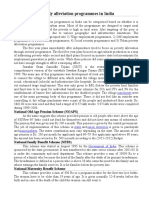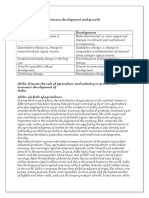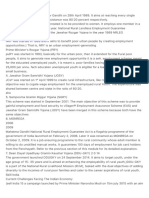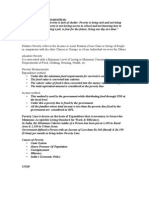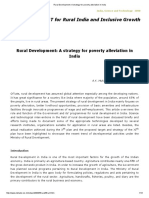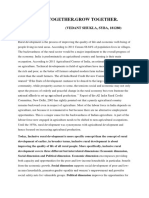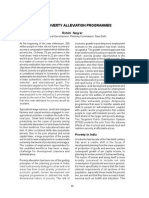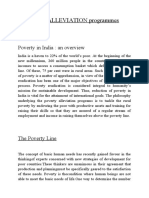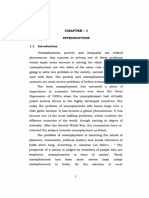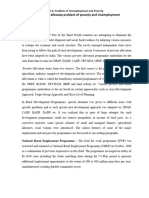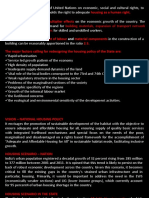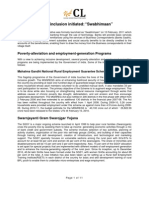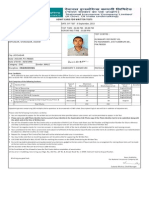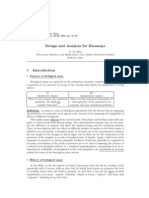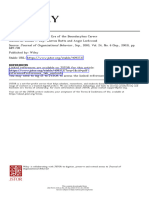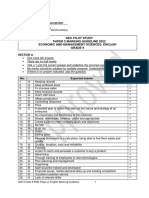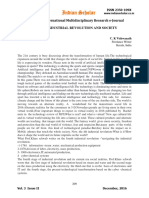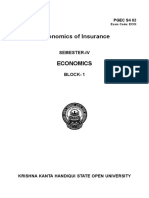"Employment Generation and Poverty Alleviation in Developing Countries" Challenges and Opportunitiesspecial Reference To India
"Employment Generation and Poverty Alleviation in Developing Countries" Challenges and Opportunitiesspecial Reference To India
Uploaded by
Mondeep PaulCopyright:
Available Formats
"Employment Generation and Poverty Alleviation in Developing Countries" Challenges and Opportunitiesspecial Reference To India
"Employment Generation and Poverty Alleviation in Developing Countries" Challenges and Opportunitiesspecial Reference To India
Uploaded by
Mondeep PaulOriginal Description:
Original Title
Copyright
Available Formats
Share this document
Did you find this document useful?
Is this content inappropriate?
Copyright:
Available Formats
"Employment Generation and Poverty Alleviation in Developing Countries" Challenges and Opportunitiesspecial Reference To India
"Employment Generation and Poverty Alleviation in Developing Countries" Challenges and Opportunitiesspecial Reference To India
Uploaded by
Mondeep PaulCopyright:
Available Formats
IOSR Journal of Business and Management (IOSR-JBM)
e-ISSN: 2278-487X, p-ISSN: 2319-7668. Volume 11, Issue 4 (Jul. - Aug. 2013), PP 18-23
www.iosrjournals.org
www.iosrjournals.org 18 | Page
Employment Generation and Poverty Alleviation in Developing
Countries Challenges and Opportunitiesspecial Reference to I ndia
1
Shubhendu S. Shukla,
2
Ashutosh Mishra
1,2
SR Group Of Institutions, Lucknow
Abstract: Implications of economic policies initiated and pursued by the Government for the creation of
gainful employment opportunities. After independence, when India initiated the programme of economic
development through planning mechanism, neither of the two prevalent economic theories i.e. the Keynesian
theory of effective demand and the neo-classical theory of flexible wage rates was not found suitable to the
Indian conditions.
Poverty reduction has been an important goal of development policy since the inception of planning in
India. Various antipoverty, employment generation and basic services programmes have been in operation for
decades in India. The ongoing reforms attach great importance to removal of poverty, and addressing
specifically the wide variations across States and the rural-urban divide. Anti-poverty strategy has three broad
components: promotion of economic growth; promotion of human development; and targeted programmes of
poverty alleviation to address multi-dimensional nature of poverty. The various programmes targeted at the
poor have been streamlined and strengthened in recent years, including through the NREGS.
The influence of macro economic environment on the industry speeds ahead economy generates more
jobs and higher levels of wages and income through increasing productivity. To achieve these objectives, series
of outward oriented policy changes i.e. industrial reforms, fiscal reforms, monetary reforms, trade policy reform
etc. were introduced. An economic reform has been evolving historically and being propelled forward with
incredible speed by the technological revolution.
I. Introduction
The present paper looks at the employment challenges faced by India within the framework of ten
core elements identified by the Global Employment Agenda of the ILO (International Labour Organization).
These elements relate to trade and investment, technological change, sustainable livelihoods, macro policy,
entrepreneurship development, skills development, active labour market policies, social protection, conditions of
work and poverty reduction.
Following are the ten core elements of the Agenda, the first four addressing the economic
environment and the last six the labour market:
1. Promoting trade and investment for productive employment and market access for developing countries.
2. Promoting technological change for higher productivity and job creation and improved standard of living.
3. Promoting sustainable development for sustainable livelihoods.
4. Macro-economic policy for growth and employment: a call for policy integration.
5. Promoting decent employment and entrepreneurship.
6. Employability by improving knowledge and skills.
7. Active labour market policies for employment, security in change, equity and poverty reduction.
8. Social protection as a productive factor.
9. Occupational safety and health: synergies between security and productivity.
10. Productive employment for poverty reduction and development.
Employment generation has been one of the important objectives of development planning in India.
The problem of employment is closely interlinked with the eradication of poverty. There are three main aspects
of the employment problem in India. They are the problem of proportion of labour to total population, problem
of productivity of labour and problem of unemployment and underemployment of labour. These three aspects are
interrelated. There is low rate participation of labour in India. Low rate of employment among women is a
striking feature in India. There has almost been no change in LFPR (Labour Force Participation Rate). The
dependency rate is quite high in India. Problem of unemployment and underemployment is the chronic feature
of the Indian economy. It is the main cause of poverty in India. Unemployment in India is mostly structural. The
rate of unemployment is different in different states. Sector wise unemployment in India is rural and urban
unemployment.
Submitted date 07 June 2013 Accepted Date: 15 June 2013
Employment Generation And Poverty Alleviation In Developing Countries Challenges And
www.iosrjournals.org 19 | Page
Urban unemployment is of two types viz, industrial unemployment and educated unemployment. Rural
unemployment is more than 70% as rural population is more than 70% of the total population in India. There are
various types of unemployment in India. They are seasonal, structural, frictional, technological, involuntary
and disguised. The productivity criterion refers to disguised unemployment. It is mainly found in agriculture. It
is a kind of underemployment. It involves both zero marginal productivity of man hour and zero marginal
productivity of labour. It implies too many persons on too little land. Educated unemployment is one variant of
open unemployment. It is mainly due to the defective educational system. Underemployment is one variant of
open unemployment.
It is mainly due to the defective educational system. Underemployment may be visible or invisible. The
ratio between unemployed workers and total labour force is called unemployment rate. Low productivity of
employment is the third aspect of the employment problem. Productivity of labour in India is low due to many
factors. The essential of the employment policy is to increase production, control population growth, reform the
education system, emphasize cottage and small scale industrial units to tackle the problem of seasonal,
frictional, structural, technological and disguised unemployment and effectively do manpower planning etc.
There have been various schemes to solve the problem of educated unemployment.
II. Anti-Poverty, Employment Generation and Basic Services Programmes
(A) Pradhan Mantri Gram Sadak Yojana (Pmgsy)
Launched in December 2000 as a 100 per cent CSS, PMGSY aims to provide all-weather connectivity
to all the eligible unconnected rural habitations. Bharat Nirman, envisages connectivity by 2009 to all the
habitations with a population of 1000 or more in the plains, and of 500 or more in the hilly, desert and tribal
areas. The systematic upgradation of the existing rural road network also is an integral component of the
scheme, funded mainly from the accruals of diesel cess in the Central Road Fund, with support of the
multilateral funding agencies and the domestic financial institutions. Up to December 2005, with an expenditure
of Rs.12,049 crore, a total length of 82,718 km. of road works had been completed. .
(B) Indira Awaas Yojana (Iay)
IAY aims to provide dwelling units, free of cost, to the Scheduled Castes (SCs), Scheduled Tribes
(STs), and freed bonded labourers, and also the non-SC/ST BPL families in rural areas. It is funded on a cost-
sharing basis in the rates of 75.25 between the Centre and the States. Under IAY, the ceiling on construction
assistance is Rs.25,000/- per unit in the plains and Rs.27,500/- for hilly/difficult areas; and Rs. 12,500/- on
upgradation of unserviceable kutcha house to pucca/semi pucca house for all areas. Up to January 30, 2006,
about 138 lakh houses had been constructed/upgraded with an expenditure of Rs.25,208 crore.
(C) Swarnjayanti Gram Swarozgar Yojana (Sgsy)
SGSY, launched in April, 1999 after restructuring the Integrated Rural Development Programme and
allied schemes, is the only self-employment programme for the rural poor. The objective is to bring the
selfemployed above the poverty line by providing them income-generating assets through bank credit and
Government subsidy. Up to November 2005, the Centre and States, sharing the costs on 75:25 basis, had
allocated Rs.8,067 crore, of which Rs. 6,980 crore had been utilized to assist 62.75 lakh self-employed.
(D) Sampoorna Grameen Rozgar Yojana (Sgry)
SGRY, launched on September 25, 2001 to provide additional wage employment in the rural areas, has
a cash and food grains component, and the Centre bears 75 per cent and 100 per cent of the cost of the two with
the balance borne by the States/UTs. In 2004-05, 82.23 crore persondays were generated with the Centre
releasing Rs. 4,496 crore as cash component and about 50 lakh tonnes of foodgrains to the States/ UTs. Besides,
under the special component of the SGRY, with the States/UTs meeting the cash components, Centre released
26 lakh tonnes of foodgrains to the 13 calamity affected States. In 2005-06 up to November, 2005, the number
of persondays generated under SGRY was 48.75 crore, while the Centres contributions in terms of the cash and
foodgrains components up to January, 2006 were Rs. 4651 crore and 35 lakh tonnes, respectively. Under the
special component, about 11.65 lakh tonnes of foodgrains have been released to the 11 calamity-hit States in the
current year
(E) National Food For Work Programme (Nffwp)
The NFFWP was launched as a CSS in November 2004 in the 150 most backward districts to generate
additional supplementary wage employment with food security. States receive food grains under NFFWP free of
cost. The focus of the programme is on works relating to water conservation, drought proofing (including
aforestation /tree plantation), land development, flood-control/protection (including drainage in waterlogged
areas), and rural connectivity in terms of all-weather roads. In 2004-05, allocation of Rs 2,020 crore and 20 lakh
Employment Generation And Poverty Alleviation In Developing Countries Challenges And
www.iosrjournals.org 20 | Page
tonnes of foodgrains generated 7.85 crore persondays of employment. In 2005-06, of the allocation of Rs 4,500
crore and 15 lakh tonnes of food grains (Revised), Rs.2,219 crore and 11.58 lakh metric tonnes of foodgrains
had been released up to January 27, 2006. About 17.03 lakh persondays were generated up to December 2005.
(F) Dpap, Ddp And Iwdp
Drought Prone Areas Programme (DPAP) was launched in 1973-74 to tackle the special problems
faced by those areas constantly affected by severe drought conditions. Desert Development Programme (DDP)
was launched in 1977-78 to mitigate the adverse effects of desertification. Integrated Wastelands Development
Programme (IWDP) has been under implementation since 1989-90 for the development of wastelands/ degraded
lands. The basis of implementation has been shifted from sectoral to watershed basis from April 1995. For 2005-
06, Rs.353 crore, Rs.268 crore and Rs.485 crore have been allocated for DPAP, DDP and IWDP, respectively.
So far in 2005-06 up to October, 2005, 3000 new projects covering 15 lakh ha., 2000 new projects covering 10
lakh ha. and 340 new projects covering 16 lakh ha. have been sanctioned under DPAP, DDP and IWDP,
respectively.
(G) Swarna Jayanti Shahari Rozgar Yojana (Sjsry)
In December 1997, the Urban Self-Employment Programme (USEP) and the Urban Wage Employment
Programme (UWEP), which are the two special components of the SJSRY, substituted for various programmes
operated earlier for urban poverty alleviation. The SJSRY is funded on a 75:25 basis between the Centre and the
States. In 2003-04, the central allocation of Rs. 94.50 crore plus Rs. 10.50 crore for North- Eastern Region
including Sikkim was fully utilized. Even 2004-05 saw the release of the entire budgetary allocation of Rs.
122.00 crore. In 2005-06, out of an allocation of Rs. 160.00 crore, Rs. 84.52 crore had been utilized until
November 30, 2005.
(H) Valmiki Ambedkar Awas Yojana (Vambay)
VAMBAY, launched in December 2001, facilitates the construction and up-gradation of dwelling units
for the slum dwellers, and provides a healthy and enabling urban environment through community toilets under
Nirmal Bharat Abhiyan, a component of the Scheme. The Central Government provides a subsidy of 50 per
cent, with the balance provided by the State Government. Since its inception and up-to December, 31 2005, Rs.
866.16 crore had been released as Central subsidy for the construction/upgradation of 4,11,478 dwelling units
and 64,247 toilet seats under the Scheme. For 2005-06, out of the tentative Central allocation of Rs. 249 crore,
up to December 31, 2005, an amount of Rs.96.4 crore had been released covering 60,335 dwelling units and 381
toilet seats.
III. The Employment Scenario
Indian economic development under different plan periods the rate of growth of output has never been
integrated with the rate of growth of employment. Accelerated economic growth has always been found to be
favourite with the Indian planners. From the very first plan this concept of economic growth was very much
interlinked with the increase in the employment opportunity, reduction of income inequality and poverty
through there was an initial debate whether reduction of income inequality was conducive to growth or not. It
Employment Generation And Poverty Alleviation In Developing Countries Challenges And
www.iosrjournals.org 21 | Page
was posed that reduction in income inequality would retard savings and hence capital formation in the LDCs,
which would slacken economic growth.
Plans Annual GDP Growth Rate
(at constant price)
Growth of Employment
First Plan (1951-56) 3.7 0.39
Second Plan (1956-61) 4.2 0.87
Third Plan (1961-66) -3.8 2.03
Fourth Plan (1969-74) 3.4 1.99
Fifth Plan (1974-78) 5.0 1.84
Sixth Plan (1980-85) 5.5 1.89
Seventh Plan (1985-90) 3.6 1.26
Eight Plan (1991-96) 6.7 1.86
Ninth Plan (1997-2002) 7.7 1.14
Tenth Plan (2002-2007) 7.2 1.23
Eleven Plan (2007 -2012) 7.5* 1.82*
Source: Plan Documents (* Approximate)
IV. Growth Of Employment By Sector
The employment generation in sartorial base i.e. primary, secondary and tertiary sectors it is fined that
in pre reform and reform period the attitude of employment opportunity is in increasing trend. Following table
indicate the growth of employment in sartorial base
Economic Sector
Employment Generated in Million
1983 1993 2000 2010
Primary Sector 208.99 (69.0) 245.16 (65.5) 239.83 (60.4) 228.43 (55.07)
Secondary sector 41.66 (13.8) 55.53 (14.8) 66.91 (16.8) 78.12 (18.82)
Tertiary sector 52.11 (17.2) 73.76 (19.7) 90.26 (22.7) 108.35 (26.11)
Total Employment 302.76 (100) 374.45 (100) 397.0 (100) 414.90 (100)
Source: Compiled and computed form the data provided by the Planning Commission Report to Task
Force on Employment Opportunities.
The growth rates of unemployment and labour force derived from NSS data are given in the above
table, the following points emerge.
1. The growth rate of employment declined from 69% to 55.07% in agriculture, mining and other production
unit in primary sector.
2. Indian economy known as rural and agro-based economy. Majority population stayed rural India, but the
employment opportunities is declined by 14.03%. It affects to decline purchasing power parity, compulsory
mobility toward urban sector etc.
3. Secondary sector witnessed an employment growth from 13.8% to 18.82%. It is an indication of development
theory regarding transfer population from primary sector to secondary sector.
4. In the tertiary sector the growth rate of employment was high. It increase 17.2% to 26.11%, the growth rate
is near about ten per cent.
5. Employment opportunities were increase in the reform period i.e. 112 million new jobs increase last twenty
years.
V. Unemployment Rate- Urban And Rural Differences
Rural areas. As against an unemployment rate of 10.3 per cent in 1977 in urban areas, the rural
unemployment rate was 7.7 per cent. There was a significant fall in the rural unemployment rate in 1990 to 5.3
per cent, but the urban unemployment rate was of the order of 9.4 per cent, significantly higher because Indian
economy was in saviour economic crisis. After the period of reform, rural unemployment rate again increased to
7.2 per cent in the year 2000 and again 8.1 per cent in 2010 while urban unemployment also marginally
increased to 7.7 per cent in the year 2000 and again decrease to 7.9 per cent in 2010. Following table indicate
the unemployment among Urban and Rural sector.
Unemployment among Urban and Rural sector
(As per cent of labour force)
Period Rural Areas Urban Areas
1977 7.7 10.3
1990 5.3 9.4
2000 7.2 8.1
2010 7.7 7.9
Employment Generation And Poverty Alleviation In Developing Countries Challenges And
www.iosrjournals.org 22 | Page
VI. Remedial Measures
The objectives of the economic reforms in India are broader since they aim at the overall economic
development of the country through the growth of industrial and agricultural sectors. During the post reform
period, despite economic growth there is low labour absorption in the Indian economy. Now there is need to
evolve a multistage strategy to generate more and more employment opportunities. Following are the some of
the measures, which may be included in this strategy.
Employment generation should be the single most important criteria for investment policy, although profits
and technological updating to be given due weightage.
Constitutional obligation ensuring Right to Work should be the function of economic planning.
Land reform, as an indispensable instrument for promoting distributive justice, for the employment of the
poor and enhancing agricultural productivity.
Rising of the domestic savings and generation of the domestic resources for investment. Foreign investment
could be used as a supplement provided, it goes where we want and not where it wants to go.
Economic reform does not mean that Government should neglect social sectors. There is need to increase
investment in social sectors, health, social security and education.
There is need to rethink and reformulate economic policies. The private sector has to be more humane and
the public sector more cost efficient. The operation of the market mechanism in a labour surplus economy
shall hardly be able to humanize the private sector.
The Government get, money through disinvestments of PSE shares, it is quite appropriate that the money
should be used to develop new and viable industrial units, and this money should not be used to finance
budget deficits or any other Government expenditures.
VII. Challenges In Employment Generation
Corruption : Corruption in employment generation agencies as well as in government system, affect badly
the employment possibilities, specially in rural areas. Although this factor cant be reduce automatically by
a common man, but it can be reduce by implementing the transparency in the system and automation in the
system such as schemes like e-district, e-Governance, RTI etc.
There is a huge gap between policy making (planning) and implementation phase of the employment
generation scheme.
Political rivalry : Every government make new and better policy still every new scheme become fail due to
political rivalry in political system. Every new Govt. either close the employment program launched by
previous Govt. or manipulate the programs guidelines or sometimes stop the fund for the program, which
makes it difficult for unemployed to get the job availability easily. This is a great factor influencing the
employment programs.
Illiteracy : Illiteracy is playing a vital role in unemployment specially in under-developed countries like
India. People even now after 60 years of independence, unaware about the schemes the Govt. is running for
the employment generation. This factor can be reduced by running awareness camp and programs parallel
to the employment programs.
Reservation / Quota (Castism) : India is a democratic country so here every Govt. provide the benefits
like employment and other employment related benefits to his caste person.
Role of Private Companies : Private companies play a vital role in the employment generation in any
country, but in India private companies are not functioning properly because of Govt. policies specially
State Govt. Companies are not investing according to his efficiency in any of the state, specially in
BIMARU States (BIhar, MAharastra, Rajasthan, Utter Pradesh) because the State Govt. is not making
policies which can attract the private companies, even States like West Bengal creating problems to private
players (TATA Singure Plant) which distract the private players from the States, ultimately affect the
employment generation.
VIII. Opportunities In Employment Generation
Huge work force : India is second largest country in the world in population after China, it means we have
a ample of work force and if this work force can be utilized accordingly, India can be top of the world. This
huge work force is attracting the developed countries for the hiring, outsourcing and for third party work.
Only the Indian Govt. have to do to train this work force according to the demand of the technology and
advancement of the third world countries.
Transparency in the system : In India now Govt understand that the people are now become technology
savvy and they adopt the new technology very soon and efficiently, so Govt is implementing the e-
Governance programs with every of the program through RTI Act.
Employment Generation And Poverty Alleviation In Developing Countries Challenges And
www.iosrjournals.org 23 | Page
Economical work force : Indian work force is very economical if it compare with any of the European
country. The average wage in India is about 100 Rs** (2.00 $ approx) where as in Europe it is about 10.00
** (700 Rs.) and in US it is about $ 12.00** (600 Rs) which mean Indian labour is ready to work on less
price as compare to European and American market, which attract the European and American player to
enter in the Indian market for the economical work.
(**source : Compiled and computed data provided by the Planning Commission Report to Task Force on
Employment Wages, Report of Statistical Survey of India)
Liberalization in Exchange Policies : The Govt has liberalized the exchange and regulation act which
makes it easy to enter in the Indian market for investment upto 100% in many sectors. This is a indirect
factor which will affect the employment factor in development point of view. Entry of new player like Wal-
Mart will not only develop the infrastructure but also create job opportunities for the educated persons in
large prospective, although it is a political issue.
References
[1]. Anker, Richard, Chernyshev I, Egger P, Mehran F and Pitter, J.A. 2003., Measuring decent work with statistical indicators i n
International Labour Review, Vol 142, No. 2, (Geneva, ILO).
[2]. Bhat, A K. 1994. Dangerous Work in The Hindu Survey of Environment, The Hindu Group of Publications, Chennai.
[3]. Bhattacharjea, Aditya. 2006, Labour market regulation and industrial, performance: A critical review of empirical evidence in The
Indian Journal of Labour Economics, Vol. 49, No.2, April-June. (New Delhi, Indian Society of Labour Economics (ISLE)).
[4]. Bescond, D, Chataignier A and Mehran, F. 2003. Seven indicators to measure decent work in International Labour Review, Vol
142, No. 2 (Geneva, ILO).
[5]. Besley, T and Bergess, R. 2004. Can regulation hinder economic performance? Evidence from India in Quarterly Journal of
Economics, Vol. 119, No.1 (Cambridge, Mass, MIT Press for Harvard University).
[6]. Chadha, G. K. 2004. What dominates the Indian labour market: Peacocks feathers or feet? in The Indian Journal of Labour
Economics, Vol. 47, No. 1, January-March (New Delhi, ISLE).
[7]. Chandra, Ashoka. 2003. Vocational Training in India (mimeo), October 17. (New Delhi, International Management Institute).
[8]. Ahluwalia, Isher & Little I.M.D. (2000), Indias Economic Reforms and Development, Oxford University Press.
[9]. Dutt, Ruddar (2003), Second Generation Economic Reforms in India, Deep & Deep Publications Pvt. Ltd.
[10]. Datt, Ruddar & K.P.M. Sundharam, (2011), Indian Economy, S.Chand & Company Ltd, New Delhi.
[11]. Eleventh (Five Year) Plan Document, Government of India
[12]. Government of India (2005-06), Economic Survey, Ministry of Finance, Economic Division, New Delhi.
[13]. IEA 84 Conference Volumes 2001.
[14]. K. K. Bagchi, (2007), Employment and Poverty Alleviation Programmes in India, Abhijeet Publi cations Delhi.
[15]. N. N. Ojha (2006), Problems of Unemployment in India, A division of Chronicle Publication Pvt. Ltd. New Delhi.
[16]. Planning Commission (2004), Report to Task Force on Employment Opportunities.
[17]. Government of India-Ministry of Finance (GOIMoF). 2007. Economic Survey, 2006-07, (New Delhi).
[18]. Government of India-Ministry of Human Resource Development (GOI-MoHRD). 2007. Selected Educational Statistics 2004-2005.
(New Delhi).
[19]. NSSO, Employment-Unemployment Situation in India (Various rounds), Ministry of Statistics and Programme Implementation
(New Delhi, GoI)
[20]. NSSO, Level and Pattern of Consumer expenditure in India (Various rounds), Ministry of Statistics and Programme Implementation
(New Delhi, GoI)
[21]. NSSO (2006), Employment-Unemployment Situation in India, 2004-05, Round 61st, Report No. 515, Ministry of Statistics and
Programme Implementation (New Delhi, GoI)
Authors profile
Author (Shubhendu S. Shukla), has completed his MA (Economics) in 2005 and MBA in 2007, and
M.Phil (Management) in 2009. He has done Post Graduated Diploma in Computer Applications from IGNOU
and Post Graduated Diploma in International Business from Annamalai University.
He has worked with a prominent IT Company (Wipro Technologies) as Project Manager for e-
Governance that was a Central Govt. Project about e-District, during his job he was responsible for Dealing
with Consultant (Wipro), dealing with Techno team i.e. Trainer and other staff, he also Co-ordinate with District
Administrative staff for monitoring, reporting, and his proposals and finally developed the Study materials.
Author has more than 5 years of experience in academics as he is currently working as Assistant
Professor in SRM Business School, Lucknow. With the academics author has publish 5 International Research
Paper, 5 National Research Papers, attended 7 National Conferences and Seminars, 2 International Seminars.
Apart from SRM Business School, he is Guest and Visiting Faculty of Study Centers of Global Open University
Nagaland, Karnataka State Open University, Sikkim Manipal University.
Author has taught variety of subjects as Marketing Management, Sales and Distribution, Production
and Operation management, Computer Application in Management, System Analysis & Design and Software
Engineering, Database Management System, Electronic Commerce (Specialized subjects of Information
Technology).
You might also like
- Impact of Startups On Local EconomyDocument53 pagesImpact of Startups On Local Economyurbanaraquib05No ratings yet
- Proposed Youth Development Centre, Oshogbo, Osun State by OMOTOSO KAYODE ADEOLADocument149 pagesProposed Youth Development Centre, Oshogbo, Osun State by OMOTOSO KAYODE ADEOLAOmotoso Kayode100% (2)
- ELECTRONICSASSEMBLYPLANTDocument48 pagesELECTRONICSASSEMBLYPLANTTesfaye Degefa100% (2)
- Poverty Alleviation Programmes - Tnpsctamil.inDocument10 pagesPoverty Alleviation Programmes - Tnpsctamil.inPrakash SundaramNo ratings yet
- Factors of UnemploymentDocument3 pagesFactors of UnemploymentNishi Shree HanumaanNo ratings yet
- RSTV: The Big Picture-Eradicating Poverty: September 1, 2019Document6 pagesRSTV: The Big Picture-Eradicating Poverty: September 1, 2019Swapnil TripathiNo ratings yet
- Swarnajayanti Gram Swarozgar YojanaDocument13 pagesSwarnajayanti Gram Swarozgar YojanaKunal AggarwalNo ratings yet
- Government Policies To Reduce Unemployment in India ReportDocument7 pagesGovernment Policies To Reduce Unemployment in India Reportketan bhereNo ratings yet
- Poverty Alleviation Programmes in India: A Social Audit: Review ArticleDocument10 pagesPoverty Alleviation Programmes in India: A Social Audit: Review ArticlekowsilaxNo ratings yet
- Government Policies To Reduce Unemployment in India ReportDocument7 pagesGovernment Policies To Reduce Unemployment in India ReportRizwan AkhtarNo ratings yet
- EcooooooooooDocument10 pagesEcooooooooootamannaNo ratings yet
- Poverty Alleviation Programmes in India Since 1950s-A Critical AnalysisDocument18 pagesPoverty Alleviation Programmes in India Since 1950s-A Critical Analysisalligater_007No ratings yet
- Unemployment ArticleDocument7 pagesUnemployment Articledeepthi k thomasNo ratings yet
- Poverty and Poverty Alleviation Programmes: Economics AssignmentDocument9 pagesPoverty and Poverty Alleviation Programmes: Economics Assignmentanshikasinha9812No ratings yet
- Brde 101 2016 2017Document8 pagesBrde 101 2016 2017kavyadeepamNo ratings yet
- Poverty Alleviation Programmes in IndiaDocument6 pagesPoverty Alleviation Programmes in IndiaMohana Ramasamy100% (1)
- Introduction To MgnregaDocument7 pagesIntroduction To MgnregaBabagouda Patil100% (1)
- Economic Plannning and PoliciesDocument7 pagesEconomic Plannning and PoliciesDWAYNENo ratings yet
- Layáhar Rozgar Yojana (JRY) 2Document8 pagesLayáhar Rozgar Yojana (JRY) 2Ajna FaizNo ratings yet
- Impact of Skill India On Nagpur Rural YouthDocument7 pagesImpact of Skill India On Nagpur Rural YouthsumantwachasundarNo ratings yet
- Eradication of PovertyDocument51 pagesEradication of PovertyDhaval Lagwankar50% (2)
- Rural DevelopmentDocument12 pagesRural DevelopmenttriratnacomNo ratings yet
- Two Ways of Poverty Relative PovertyDocument12 pagesTwo Ways of Poverty Relative PovertyUdit AnandNo ratings yet
- Rural Development - A Strategy For Poverty Alleviation in IndiaDocument13 pagesRural Development - A Strategy For Poverty Alleviation in IndiaChandrika DasNo ratings yet
- 1 PPT Unit 1 Rural DevelopmentDocument29 pages1 PPT Unit 1 Rural Developmentsumit sharmaNo ratings yet
- NCERT Economics Class 10 NotesDocument16 pagesNCERT Economics Class 10 NotesPrachi ChoudharyNo ratings yet
- Module 3-DevelopmentDocument43 pagesModule 3-Developmentshubham kumarNo ratings yet
- Eco Honours OrignalDocument9 pagesEco Honours OrignalVedant ShuklaNo ratings yet
- Chapter 4 Poverty Allevaition and Employment Generation in India PDFDocument11 pagesChapter 4 Poverty Allevaition and Employment Generation in India PDFRahul SharmaNo ratings yet
- IRMA-TISS Compendium 2013Document11 pagesIRMA-TISS Compendium 2013Ethan HuntNo ratings yet
- NITI Ayog Inclusive GrowthDocument6 pagesNITI Ayog Inclusive Growthakumky24thongzNo ratings yet
- Povert Allevation ProgrammesDocument11 pagesPovert Allevation ProgrammesPreetha BalajiNo ratings yet
- ECONOMICS PROJECT Term 2Document15 pagesECONOMICS PROJECT Term 2avni kajariaNo ratings yet
- Rural and Urban DevelopmentDocument8 pagesRural and Urban DevelopmentIsha JainNo ratings yet
- Critical Analysis of The Mahatma Gandhi National Rural Employment Guarantee Act MgnregaDocument5 pagesCritical Analysis of The Mahatma Gandhi National Rural Employment Guarantee Act MgnregaBANDANA SAIKIANo ratings yet
- Author: Human Resource Development in Rural India (Document15 pagesAuthor: Human Resource Development in Rural India (Khalid NawaserNo ratings yet
- Programmes of Employment Generation and Poverty Alleviation in IndiaDocument7 pagesProgrammes of Employment Generation and Poverty Alleviation in IndiaVijayalakshmi AmrutheshaNo ratings yet
- UnemploymentDocument12 pagesUnemploymentRavi SinghalNo ratings yet
- POVERTY ALLEVIATION Programmes: Poverty in India: An OverviewDocument13 pagesPOVERTY ALLEVIATION Programmes: Poverty in India: An Overviewsubi543No ratings yet
- 12555study Material For 6th Sem Economics Hons 09 ChapterDocument27 pages12555study Material For 6th Sem Economics Hons 09 ChapterDivyanshi Rajpoot 249No ratings yet
- Eco ProjectDocument23 pagesEco Projectxia49.sresthadasNo ratings yet
- A Project ON: "Rural Development of India"Document20 pagesA Project ON: "Rural Development of India"manishrawat21No ratings yet
- According To World Bank, Poverty Is Pronounced Deprivation inDocument5 pagesAccording To World Bank, Poverty Is Pronounced Deprivation inDevyani Joshi 11 'A'No ratings yet
- Effectiveness of Poverty Alleviation Programmes in IndiaDocument32 pagesEffectiveness of Poverty Alleviation Programmes in IndiaVaishali Uzziel67% (6)
- Eco Ch. 3 Poverty As A ChallengeDocument4 pagesEco Ch. 3 Poverty As A Challengesoni561980No ratings yet
- Poverty Alleviation Programmes in IndiaDocument26 pagesPoverty Alleviation Programmes in IndiautkarshNo ratings yet
- Layáhar Rozgar Yojana (JRY)Document2 pagesLayáhar Rozgar Yojana (JRY)Ajna FaizNo ratings yet
- govt efforts to check poverty unemploymentDocument4 pagesgovt efforts to check poverty unemploymentazhardilbagNo ratings yet
- List of Indian SchemesDocument12 pagesList of Indian SchemestrskaranNo ratings yet
- Mahatma Gandhi National Rural Employment GuaranteeDocument24 pagesMahatma Gandhi National Rural Employment GuaranteePragyan NibeditaNo ratings yet
- Poverty Alleviation and Employment Generation Programs in IndiaDocument3 pagesPoverty Alleviation and Employment Generation Programs in Indiacentmusic8No ratings yet
- Poverty Alleviation Programmes in IndiaDocument16 pagesPoverty Alleviation Programmes in Indianeha100% (1)
- HousingDocument20 pagesHousingPrayag SV100% (1)
- Employment in IndiaDocument7 pagesEmployment in IndiaASHISH UPADHYAYNo ratings yet
- IRMA Compendium 2011Document11 pagesIRMA Compendium 2011Richa GargNo ratings yet
- Disguised Unemployment in IndiaDocument5 pagesDisguised Unemployment in Indiamansinagpal2450% (2)
- Essay Score Booster Toolkit_IAS PCS PathshalaDocument153 pagesEssay Score Booster Toolkit_IAS PCS PathshalakarunaNo ratings yet
- Poverty As A ChallengeDocument3 pagesPoverty As A ChallengeMuhamed Fadhil FiroshghanNo ratings yet
- Sgsy Paper: June 2021Document7 pagesSgsy Paper: June 2021ima doucheNo ratings yet
- Population Growth and Unemployment in India By Caste: Path Analysis: Unemployment by CasteFrom EverandPopulation Growth and Unemployment in India By Caste: Path Analysis: Unemployment by CasteNo ratings yet
- A Dmit Ca RD For W Ritten Tests: Dear C AndidateDocument1 pageA Dmit Ca RD For W Ritten Tests: Dear C AndidateMondeep PaulNo ratings yet
- b896946693e34869a9a36b54c3c4a5d9Document2 pagesb896946693e34869a9a36b54c3c4a5d9Mondeep PaulNo ratings yet
- Uttaranchal Gramin Bank Clerk Exam 2012 Solved Paper: General English (Exam Held On 12-2-2012)Document10 pagesUttaranchal Gramin Bank Clerk Exam 2012 Solved Paper: General English (Exam Held On 12-2-2012)Mondeep PaulNo ratings yet
- Adv Non-Faculty PositionDocument2 pagesAdv Non-Faculty PositionMondeep PaulNo ratings yet
- National Institute of Open SchoolingDocument6 pagesNational Institute of Open SchoolingMondeep PaulNo ratings yet
- Design and Analysis For Bioassays: Design Workshop Lecture Notes ISI, Kolkata, November, 25-29, 2002, Pp. 61-76Document16 pagesDesign and Analysis For Bioassays: Design Workshop Lecture Notes ISI, Kolkata, November, 25-29, 2002, Pp. 61-76Mondeep PaulNo ratings yet
- Personal and Family Traits of Marwadi EntrepreneursDocument40 pagesPersonal and Family Traits of Marwadi EntrepreneursVinit MathurNo ratings yet
- Employers' Perception On Soft Skills of GraduatesDocument9 pagesEmployers' Perception On Soft Skills of Graduatesnur jannahNo ratings yet
- Chapter 2 SlideDocument63 pagesChapter 2 Slidekhanhly2k41107No ratings yet
- DHA's Privatization of Clifton Beach in KarachiDocument4 pagesDHA's Privatization of Clifton Beach in KarachiKO100% (9)
- 1997 El Rol de Los Sesgos en Las Negociaciones PDFDocument46 pages1997 El Rol de Los Sesgos en Las Negociaciones PDFSergio OrdóñezNo ratings yet
- Agricultural Rural MarketingDocument50 pagesAgricultural Rural MarketingRajas KoreNo ratings yet
- Why Go To CollegeDocument1 pageWhy Go To Collegeapi-359848967No ratings yet
- Mock Exam 24Document8 pagesMock Exam 24SHAHID BASSIRANo ratings yet
- Assessing The Economic Policies of President Lula Da Silva in BrazilDocument26 pagesAssessing The Economic Policies of President Lula Da Silva in BrazilcabamaroNo ratings yet
- AssignmentDocument8 pagesAssignmentclassicalrafiNo ratings yet
- (Eby, 2003) Predictors of Success in The Era of The Boundaryless CareerDocument21 pages(Eby, 2003) Predictors of Success in The Era of The Boundaryless CareerAdeline HegaNo ratings yet
- s.5 s.6 Economics Scheme of Work Revision Past PapersDocument10 pagess.5 s.6 Economics Scheme of Work Revision Past Paperssarahnakirayi3No ratings yet
- 2004 Tipping Points SectionDocument20 pages2004 Tipping Points SectiondallasnewsNo ratings yet
- Mesfen Busines ProposalDocument32 pagesMesfen Busines ProposalSemir100% (1)
- BUSINESS PROBLEM STATEMENT On UnemploymentDocument8 pagesBUSINESS PROBLEM STATEMENT On UnemploymentAkash MathewsNo ratings yet
- Final The Effects of Covid-19 On The Working Environment of Workers in Department StoresDocument58 pagesFinal The Effects of Covid-19 On The Working Environment of Workers in Department StoresJoan MonteroNo ratings yet
- Macroeconomics: Welcome To ECON 2123 (L2), HKUSTDocument58 pagesMacroeconomics: Welcome To ECON 2123 (L2), HKUSTyaoamber9628No ratings yet
- Mr. Phiri's Final DissertationDocument63 pagesMr. Phiri's Final DissertationGM-Kasuba P MbuloNo ratings yet
- Grade 9 EMS English Memo Paper 2Document3 pagesGrade 9 EMS English Memo Paper 2Masala RambudaNo ratings yet
- Budget Statement 2011-2012: NamibiaDocument35 pagesBudget Statement 2011-2012: NamibiaAndré Le RouxNo ratings yet
- MAR0616 Thesis Hrund Einarsdo$0301ttir The+Impact+of+Economic+Crisis+on+Buying+Behavior+and+Consumer+AttitudesDocument74 pagesMAR0616 Thesis Hrund Einarsdo$0301ttir The+Impact+of+Economic+Crisis+on+Buying+Behavior+and+Consumer+AttitudesLubdh PandaNo ratings yet
- IeltsDocument14 pagesIeltsДина ЖаксыбаеваNo ratings yet
- Ayesha SiddiqaDocument10 pagesAyesha SiddiqaayeshaNo ratings yet
- The Fourth Industrial Revolution and Its Impacts On SocietyDocument5 pagesThe Fourth Industrial Revolution and Its Impacts On SocietySujith GNo ratings yet
- 40. (Sau MH) ĐỀ THI THỬ TN THPT 2023 - MÔN TIẾNG ANH - THPT Chuyên Phan Bội Châu - Nghệ An (Lần 2) (Bản word có lời giải chi tiết)Document31 pages40. (Sau MH) ĐỀ THI THỬ TN THPT 2023 - MÔN TIẾNG ANH - THPT Chuyên Phan Bội Châu - Nghệ An (Lần 2) (Bản word có lời giải chi tiết)Thảo LôNo ratings yet
- Economics of Insurance - Block - 1Document123 pagesEconomics of Insurance - Block - 1Daily Krishna KathaNo ratings yet
- Density & Distribution of Population in BangladeshDocument13 pagesDensity & Distribution of Population in BangladeshMizanur RahmanNo ratings yet















